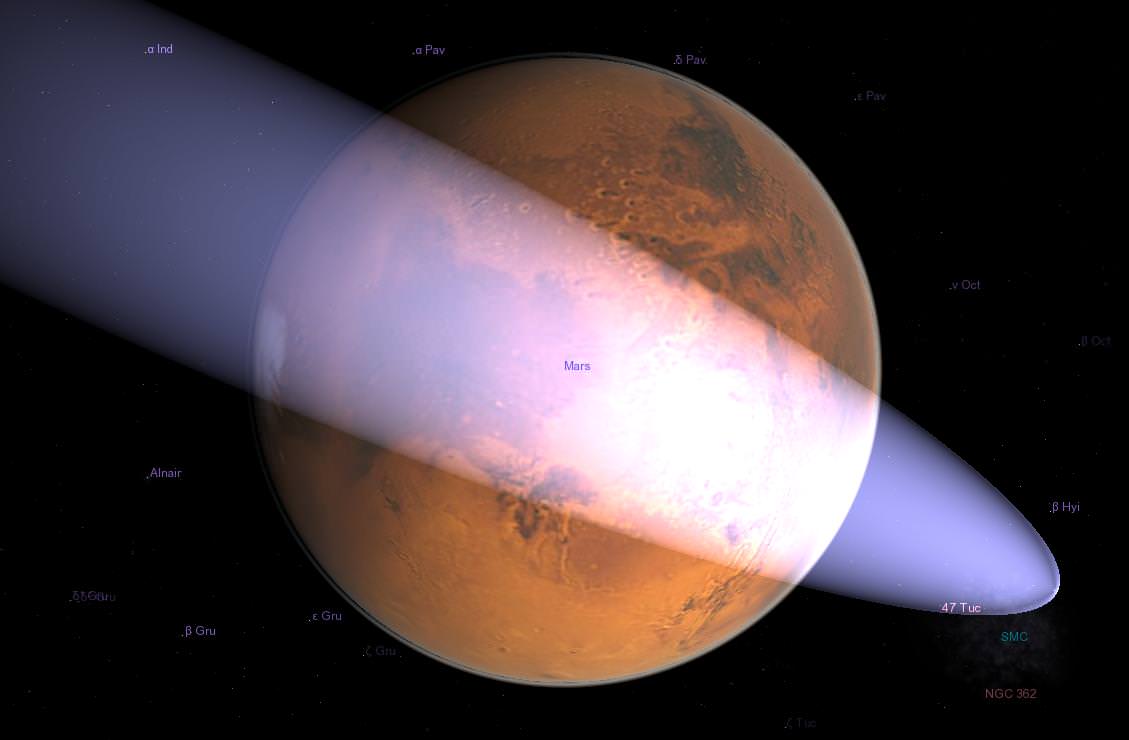The latest trajectory of comet 2013 A1 (Siding Spring) generated by the Near-Earth Object Program Office at the Jet Propulsion Laboratory indicates the comet will pass within 186,000 miles (300,000 kilometers) of Mars in October of 2014, and there is a strong possibility that it might pass much closer. The NEO Program Office’s current estimate based on observations through March 1, 2013, has it passing about 31,000 miles (50,000 kilometers) from the Red Planet’s surface. That distance is about two-and-a-half times that of the orbit of outermost moon, Deimos.
Previous estimates put it on a possible collision course with Mars.
This video, above, is based on comet’s orbit calculated by Leonid Elenin, which has it is coming within 58,000 km, and visualized by SpaceEngine software.
The trajectory for comet Siding Spring is being refined as more observations are made. Rob McNaught discovered this comet on Jan. 3, 2013, at Siding Spring Observatory in Australia, and looking back at archival observations has unearthed more images of the comet, extending the observation interval back to Oct. 4, 2012. Further refinement to its orbit is expected as more observational data is obtained.
“At present, Mars lies within the range of possible paths for the comet and the possibility of an impact cannot be excluded,” said an update today from JPL. “However, since the impact probability is currently less than one in 600, future observations are expected to provide data that will completely rule out a Mars impact.”
JPL’s update also outlined how during the close Mars approach, the comet will likely achieve a total visual magnitude of zero or brighter, as seen from Mars-based spacecraft. From Earth, the comet is not expected to reach naked eye brightness, but it may become bright enough (about magnitude 8) that it could be viewed from the southern hemisphere in mid-September 2014, using binoculars, or small telescopes.
Siding Spring likely originated from the Oort cloud. Amateur and professional astronomers will be keeping an eye on this comet’s trajectory to determine if it will end up hitting Mars or not.
Source: JPL


Very disappointed here that Mars will not be destroyed. Back to plan B.
“It obstructs our view of Jupiter! We need a Illudium Q-36 Explosive Space Modulator!”
Its funny how badly I want this comet to hit Mars.
I mean, if Earth was the target Id be terrified. I cant help but feel a tad hypocritical.
Would this have been visible to WISE. Are comets brighter in the infrared? At the time the comet was between Saturn’s and Jupiter’s orbit.
Any chance of Mars altering its path to come anywhere close to earth? Just curios.
About as likely as a freight train altering its path after striking a pigeon that cross it.
I’m reassured that the comet’s orbit is well out of the plane of the solar system and, from the video, it looks as though it will probably be deflected away from the sun by Mars There should be quite a spectacular view from the Mars orbiters and rovers and the chance to check out gravitic deflection of comets should we need to do it ourselves.
The acceleration of Mars due to impact, A = F/M where F= force M= Mass
Mass of Mars: 6.41 x 10 ^23Kg
Worst case size of 50km diameter comet fed into a crater calculator with a density of water gives a yield of 24,434,609,528 megatons
using another converter that’s 1.004 x 10^26 Newton Metres
assuming a right angle hit, crater depth is 83Km so force applied over 83,000m
1.004 x 10^26 / 83000 = 1.2 x 10^21 Newtons
1.2 x 10^21 / 6.4 x 10^23 = 0.002 metres/sec/sec
that’s about 20 times the acceleration of an NSTAR ion drive on a 1 tonne spacecraft.
Acceleration would be applied for the 1.5 secs it takes to make the crater. = .003m/sec which is about 96Km a year.
Even without impacting Mars, debris in the coma may pose a hazard to the orbiting fleet of satellites already at Mars and possibly imperil the MAVEN (US) and Mangalyaan (India) missions due to arrive in 2014.
Ala Comet Shoemaker/Levy 9, this comet MAY break into pieces when it passes Mars? Proximity dependent – those pieces could then be ‘flung’ into a new orbits around Mars or? Donno if it’s possible for those pieces to be accelerated fast enough to reach the inner solar system? Bottom line is that anything can happen… and usually does!
Today mars Tomorrow earth, wake up earthlings!!
After the 2012 prediction fiasco, you should already know the answer: “NO”
Am I simply missing the dates for this near miss?
Go away, I’m sleepin’.
I was pretty excited when it was at 1 in 125, then it dropped to 1 in 600. What if that’s what the royal cyborg sorcerer lizard aliens want us to believe, and they finally gave up and threw a comet Directly at Mars to finally settle there. Hmmmmmmm?
The sad thing about this event is that we just detected this comet and if it were going to hit the Earth (it won’t) our space program is not up to the task of deflecting “fire power of that magnitude.” With all the money that the US spent on fighting two wars over the last 10 years we could have built up our space program and started taking our first steps into the final frontier. WIth an awesome space program we could have deflected this comet into Mars and that would have been a step towards martian colonization. As a species I think we need to re-examine our priorities.
No.
Need a lot of comets to start hitting Mars to re-create the “soup of life”.